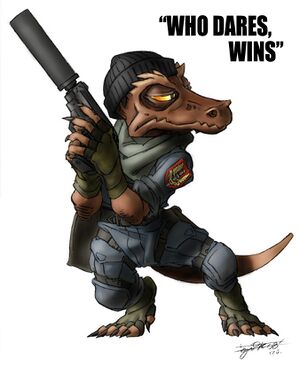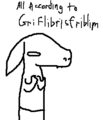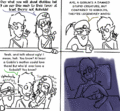Kobold

Kobolds are a race of creatures from the Dungeons & Dragons series of games. They've undergone a great deal of remodelling over the editions, going from big-eyed goblin-kin in OD&D to horned ratmen/dogmen in AD&D to their final iteration in 3rd edition, where they became puny reptilian creatures that were possibly related in some way to dragons. In either case, they are small, weak creatures, generally serving in most campaigns as low-level cannon fodder for the adventurers to mow down, much like goblins and orcs.
Despite being physically weak, however, kobolds are also described as capable trapsmiths, and are known for creating traps to protect their lairs and dungeons (a habit that is usually ignored or underplayed by most DMs). This habit - combined with a penchant for lethal tunnel design and group tactics - were famously used in the tale of Tucker's Kobolds to illustrate that kobolds - and, indeed, any intelligent creature - can remain dangerous to high-level adventurers despite being statistically inferior in just about every way.
There is a market in 3.5 for kobold PCs, since their draconian/reptilian ancestry make them one of the only +0 Level Adjustment races capable of qualifying for much of the additional material in splatbooks like the Draconomicon and the Book of Dragons. Pun-Pun, for example, is a rather famous CharOp design that allows a kobold wizard to attain theoretically unlimited abilities and attributes, using material from splatbooks and the Forgotten Realms campaign setting.
While 4e technically does allow for 0LA characters using the "racial features" rules in the Monster Manual, they effectively play like reptilian halflings, which get better bonuses. The lack of splat and reptilian-based bonuses makes them less appealing than 3e, but their inherent trap skills make them excellent rogues.
It is worth noting that if played with the intention of being dangerous, kobolds are far and away the hardest throwaway monsters to fight. It could be likened to a sort of sick, hardcore version of Home Alone, with the kobolds taking the part of a severely deranged and sadistic Kevin McCallister and the PCs taking the part of hopelessly underprepared thugs walking into a situation they cannot have possibly foreseen. If treated like cannon fodder, they are the absolute hands-down easiest things in any edition to kill, including housecats and electric iguanas.
Kobolds are often used as "weakling" monsters in games, particularly video games based on the pen-and-paper variety. Their actual versatility depends on the system, but like D&D runs the gamut of harmless to devastating in numbers to downright impossible. While modern D&D paints them as reptilian creatures, some other games and media portray them as either wolf/dog-like (such as Dwarf Fortress) or rat-like (Warcraft).
D&D Stats
Kobolds have long been one of the playable monstrous races of Dungeons & Dragons, although their precise mechanical crunch has been... kind of hit and miss. Pathfinder and 5th edition's versions in particular have often been angrily derided for actually being weaker than Goblins, who are supposed to be on roughly the same level of inferiority on the totem pole.
AD&D/2nd Edition
From the Complete Book of Humanoids.
3rd Edition
From Races of the Dragon.
Pathfinder
From Advanced Race Guide.
4th Edition
From Monster Manual 1.
5th Edition
From Volo's Guide to Monsters.
Real life Kobold
Those of us who took high school chemistry will remember element 27 on the periodic table is named "cobalt," which sounds similar to kobold. In fact, cobalt ore was named by German miners after the stories of these malevolent underground spirits. The ore is naturally found as sharp shards, bonded with arsenic oxide. The shards are sharp enough to penetrate boots and feet, hurting miners and making them sick just as if they were poisoned caltrop traps left by kobolds.
A "cobalt bomb" is a proposed nuclear weapon designed to poison a large territory with super-radioactive cobalt dust, making the target area uninhabitable for 105 years. The short half-life makes it especially deadly, but possible for your great-grandchildren to recover the empty territory. So watch out for "kobold bombs" on "magic missiles".
Cutebolds
Cutebolds are like Kobolds only incredibly cute.
They are pitiful and childish in everything they do, and are innocent enough to not know how to procreate. All they know is that rubbing their noses gives them a guilty pleasure. They are no less "harmless" when played properly, though. They tend toward the dog-like for extra D'aww.
This interpretation of the Kobold is thought to have been inspired by their depiction in Dwarf Fortress, where they steal your supplies, but seem to do it in the most endearingly stupid manner possible.
Cutebold stats:
- +2 Dex, +2 Cha, -2 Int
- Charm person once per day as a spell like ability
- Low light vision and scent
-
There's no word in kobold for "keikaku"
-
Kobold Camp now with 3D rendering
-
Love can bloom under a battlefield
-
Aw, they think they're people!
-
Someone's got a widdle crush!
See also
| Dungeons & Dragons 4th Edition Races | |
|---|---|
| Player's Handbook 1 | Dragonborn • Dwarf • Eladrin • Elf • Half-Elf • Halfling • Human • Tiefling |
| Player's Handbook 2 | Deva • Gnome • Goliath • Half-Orc • Shifter |
| Player's Handbook 3 | Githzerai • Minotaur • Shardmind • Wilden |
| Monster Manual 1: | Bugbear • Doppelganger • Githyanki • Goblin • Hobgoblin • Kobold • Orc |
| Monster Manual 2 | Bullywug • Duergar • Kenku |
| Dragon Magazine | Gnoll • Shadar-kai |
| Heroes of Shadow | Revenant • Shade • Vryloka |
| Heroes of the Feywild | Hamadryad • Pixie • Satyr |
| Eberron's Player's Guide | Changeling • Kalashtar • Warforged |
| The Manual of the Planes | Bladeling |
| Dark Sun Campaign Setting | Mul • Thri-kreen |
| Forgotten Realms Player's Guide | Drow • Genasi |





